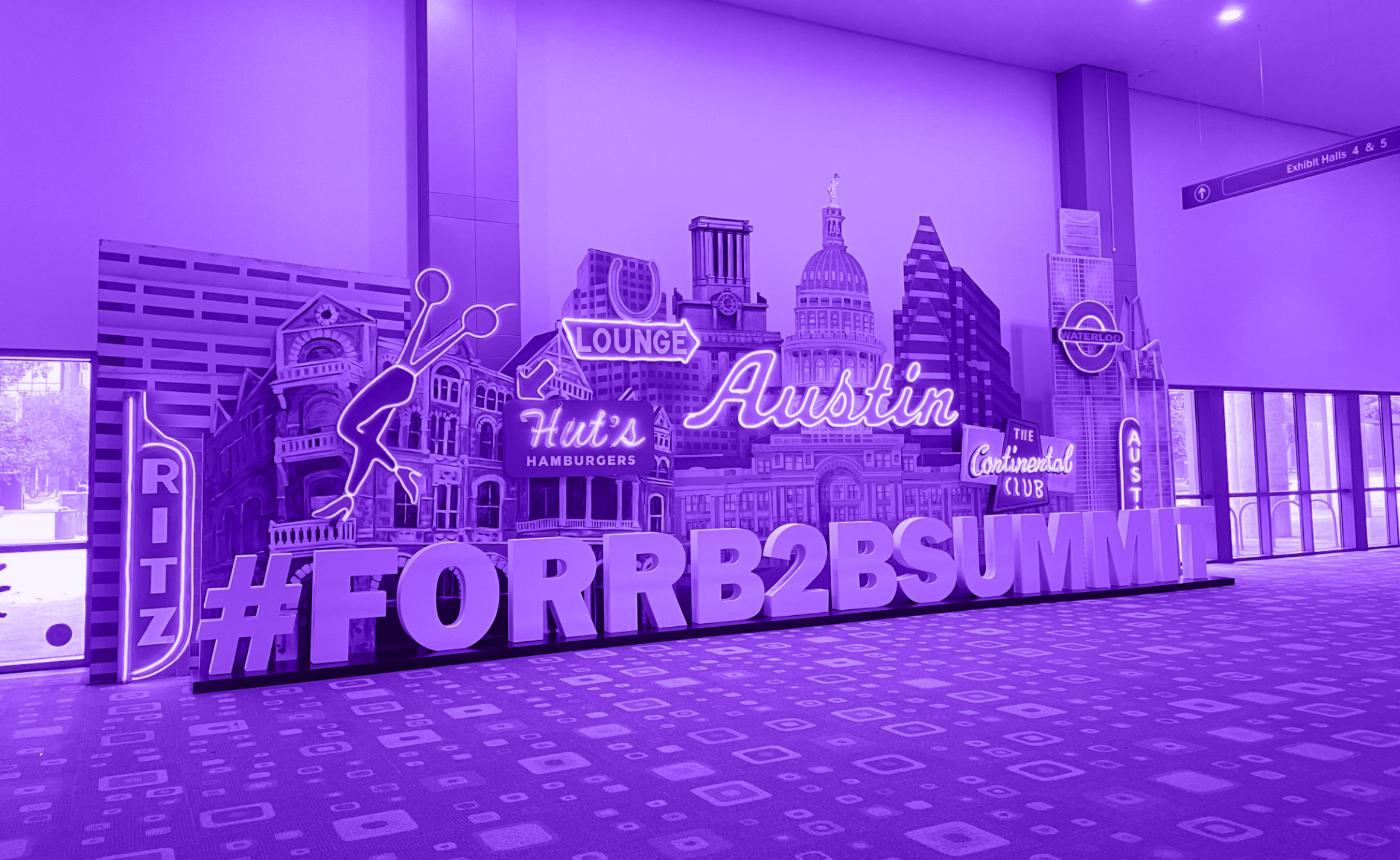The Forrester B2B Summit has just concluded in Austin. Imagine a few days where we traded endless spreadsheets for impeccable BBQ, breathtaking Texas sunsets, and strategic acumen.
It was a refreshing change of pace, reconnecting with clients, sharing hard-earned lessons with colleagues, and absorbing a wealth of B2B marketing insights.
Before we delve back into data, presentations, and strategies, we’re eager to share our highlights from the week. After attending numerous workshops, keynote addresses, and detailed sessions, our team convened and identified three overarching themes that stood out to us:
• Customer-centricity
• A focus on data
• Welcoming change, including AI
So, how are these themes reflected in the content shared by Forrester’s analysts? Let’s break down our nine top learnings from the 2024 Forrester B2B Summit.
1. Opportunity-centricity is in
Forrester’s experts say we’re seeing a shift away from traditional lead-centric approaches, which focus too closely on individual needs, to opportunity-centric models that better align with how B2B decisions are made by groups rather than individuals.
In fact, 92% of B2B buying decisions are made by a group of two or more people.
One easy way to make this change is to adopt B2B Revenue Waterfall because it prioritizes opportunities over leads. According to the data shared, Forrester clients that have successfully implemented the Waterfall have seen huge improvements in conversion rates and revenue growth, ranging from 40% to 400%.
For more on Forrester’s B2B Revenue Waterfall model, check out our Day 1 summary here.
2. Adapting to younger buyers’ needs
As a new breed of B2B buyers — young people under the age of 45 — begin moving into key decision-making roles, marketers need to shift their strategies to cater to this younger audience.
Why? Because the new generation’s needs, priorities, and behaviors differ greatly from what many of us are used to.
“These younger buyers have never heard the sound of a fax machine screeching in the background. They don’t even like email. That’s old school; they prefer to be reached on their phones in Teams or Slack.”
Forrester’s analysts suggest adapting to meet these younger buyers by shifting B2B marketing strategies towards more modern, socially responsible, and environmentally sustainable practices, reflecting their preferences for digital communication and collaborative decision-making.
3. Needs-based segmentation triumphs
But according to Forrester, there’s more we can all do, as tailoring marketing efforts based on detailed customer segmentation is more important now than ever.
That means embracing segmentation models. By precisely targeting segmented audiences, we can align our strategies and offerings to better meet the evolving expectations of diverse customer groups.
“There’s so much information that you can gather inside of your own company… win-loss analysis, financials, industry reports, conversational intelligence – all are valuable.”
4. Traditional sales metrics are out
If you want to grow, you need to forget what you’re used to. That means moving away from traditional sales metrics and adopting customer value as a key revenue driver.
Forrester says organizations that want to stay competitive and drive long-term growth will begin transforming their revenue processes with an integrated opportunity lifecycle that emphasizes customer value at every stage.
5. Cross-functional collaboration is a must
Across the talks we attended, one universal truth was shared: the future of effective B2B marketing lies in breaking down silos and fostering collaboration across functions.
When marketing, sales, and customer success teams collaborate and share resources and insights, businesses will experience a ton of benefits, including:
• Increased chances of achieving shared revenue goals
• Less finger-pointing when things go wrong
• A more cohesive buyer experience, making it easier for buyers to navigate the purchasing process
• Improved revenue growth and customer satisfaction!
42% of sales leaders feel a lack of strategic alignment with marketing or other functions is the most significant challenge to their organization’s sales enablement function.
Long story short, cross-functional collaboration is a must for creating seamless buyer experiences!
6. We’re living in a post-ABM world
No, ABM isn’t dead! But its success as a strategy has reached a point where it’s become BAU for many growth-minded businesses, according to Forrester.
Now ABM has become standard practice, we’ll start seeing a shift towards account-based experience, or ABX, which integrates marketing efforts across the entire customer lifecycle.
Check out our Day 2 round-up here to learn more about what Forrester sees in the future of B2B marketing.
7. Embracing data-driven decision-making
Any marketer worth their salt knows that good quality data is crucial to effective decision-making.
Forrester’s analysts have identified a growing trend in this area: leveraging real-time first-party and third-party data to enhance marketing and sales alignment by informing strategic decision-making.
In practice, this involves moving beyond traditional MQLs to focus on buyer intent. By looking out for intent signals like direct interest, content consumption patterns, and third-party intent data from platforms like Bombora, marketers can catch potential opportunities before their competition has a chance to blink.
8. The generative AI advantage
AI is here to stay, and Forrester has one big piece of advice: don’t let AI happen to you.
“Don’t wait for AI to ‘happen’ to you—take proactive steps and choose action over hesitation.” – Seth Marrs
If you’re hesitant to make the most of the power of generative AI or feel overwhelmed by all the options, you need to dive in, start experimenting, and unleash AI’s transformative potential.
So, how can businesses transform B2B marketing and sales with AI? By automating processes, enhancing personalization, and enabling predictive analytics.
And this is just scratching the surface of the importance of AI! For more, read our Day 3 highlights here.
9. Learning never stops!
One of the reasons we love B2B marketing so much is that it’s a fast-moving industry, so you can never grow complacent.
That means the learning never stops. Forrester’s analysts suggest organizations should prioritize investing in ongoing training in areas relevant to our work and in the development of skills that align with future market requirements, like strategic thinking and creative problem-solving.
What’s next?
Well, that’s a wrap for us in Austin in 2024! We’re excited to put these practices into action and are already looking forward to Forrester’s 2025 event.
For more insights on B2B marketing, follow and connect with us on LinkedIn.



